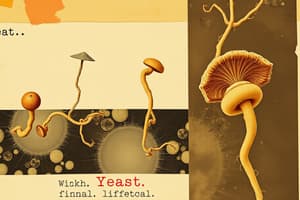Podcast
Questions and Answers
What is the primary mode of nutrition for most fungi?
What is the primary mode of nutrition for most fungi?
- Endocytosis
- Absorption through leaves
- Extracellular digestion (correct)
- Photosynthesis
What is the term for the collection of hyphae in fungi?
What is the term for the collection of hyphae in fungi?
- Mycelium (correct)
- Rhizopus
- Substrate
- Stolon
Which fungus is an example of a parasitic organism?
Which fungus is an example of a parasitic organism?
- Field mushroom (Psalliota campestris)
- The destroying Angel (Amanita phalloides)
- Athlete’s Foot (correct)
- Rhizopus
What is the haploid nature of Rhizopus?
What is the haploid nature of Rhizopus?
What is the primary characteristic that classifies fungi as Eukaryotic organisms?
What is the primary characteristic that classifies fungi as Eukaryotic organisms?
What is the substance on which hyphae grow called?
What is the substance on which hyphae grow called?
What is the term for the aerial hyphae growing horizontally in fungi?
What is the term for the aerial hyphae growing horizontally in fungi?
What is the term for fungi that obtain nourishment by breaking down plant and animal material?
What is the term for fungi that obtain nourishment by breaking down plant and animal material?
What is the term for the process through which fungi obtain their nourishment?
What is the term for the process through which fungi obtain their nourishment?
Which fungus is an example of an edible and harmless organism?
Which fungus is an example of an edible and harmless organism?
Which process is involved in asexual reproduction of Rhizopus?
Which process is involved in asexual reproduction of Rhizopus?
What is the role of baker’s yeast in baking and fermentation?
What is the role of baker’s yeast in baking and fermentation?
What is the mode of reproduction for yeast when food is plentiful?
What is the mode of reproduction for yeast when food is plentiful?
What is the economic benefit of yeast like Saccharomyces cerevisiae?
What is the economic benefit of yeast like Saccharomyces cerevisiae?
What is the role of zygospores in sexual reproduction of Rhizopus?
What is the role of zygospores in sexual reproduction of Rhizopus?
What is the mode of obtaining minerals for baker’s yeast?
What is the mode of obtaining minerals for baker’s yeast?
What is the method used to observe the growth of leaf yeast in a practical investigation?
What is the method used to observe the growth of leaf yeast in a practical investigation?
What is the aim of the practical investigation involving leaf yeast?
What is the aim of the practical investigation involving leaf yeast?
Why are aseptic techniques crucial in the practical investigation?
Why are aseptic techniques crucial in the practical investigation?
What is the method used to obtain energy by yeast?
What is the method used to obtain energy by yeast?
Study Notes
Fungal Reproduction and Economic Importance
- Rhizopus spreads through the surface, forming rhizoids that release digestive enzymes and absorb digested food.
- Asexual reproduction in Rhizopus involves the formation of haploid spores within a sporangium, released upon maturity and carried by wind for germination.
- Sexual reproduction in Rhizopus occurs when hyphae of different strains fuse to form a zygospore, which can withstand adverse conditions until germination.
- Yeast, such as Saccharomyces cerevisiae, is a unicellular fungus used in baking and fermentation.
- Baker’s yeast is a saprophyte obtaining minerals from sugar-rich solutions, while Candida albicans is a common parasitic yeast causing infections.
- Yeast obtains energy through anaerobic respiration of sugars, producing ethanol and carbon dioxide.
- Yeast reproduces asexually through budding, forming new cells if food is plentiful, leading to the formation of pseudomycelium.
- Fungi have economic benefits such as alcohol production, cheese flavoring, and penicillin, but also cause diseases like Athlete’s Foot and contribute to agricultural problems.
- A practical investigation involves studying the growth of leaf yeast using agar plates and controls, emphasizing aseptic techniques and precautions.
- Steps for aseptic technique include flaming equipment, sealing experiments, minimizing openings, disinfecting after use, and proper disposal.
- The practical aims to observe shiny pink colonies on the agar plate containing the leaf, and no colonies on the empty dish, verifying the growth of leaf yeast.
- Aseptic techniques are crucial to prevent contamination, as many microorganisms are pathogenic and can cause harm to humans and the environment.
Studying That Suits You
Use AI to generate personalized quizzes and flashcards to suit your learning preferences.
Related Documents
Description
Test your knowledge of fungal reproduction and economic importance with this quiz. Explore topics such as Rhizopus asexual and sexual reproduction, the role of yeast in baking and fermentation, economic benefits of fungi, and practical investigations involving aseptic techniques. Learn about the significance of fungi in both beneficial and harmful aspects, and the precautions necessary to prevent contamination.




